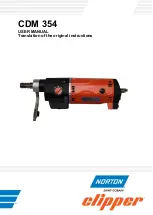
diseases to the operator or bystanders. Certain
kinds of dust are classified as carcinogenic such
as oak and beech dust especially in conjunction
with additives for wood conditioning (chromate,
wood preservative). Material containing asbestos
must only be treated by specialists.
Where the
use of a dust extraction device is possible it
shall be used. To achieve a high level of dust
collection, use a suitable vacuum cleaner of the
type recommended by Hilti for wood dust and/or
mineral dust together with this tool. Ensure that
the workplace is well ventilated. The use of a
dust mask of filter class P2 is recommended.
Follow national requirements for the materials
you want to work with.
5.2.2 Power tool use and care
a)
Secure the workpiece. Use clamps or a vice
to secure the workpiece.
The workpiece is thus
held more securely than by hand and both hands
remain free to operate the power tool.
b)
Check that the insert tools used are compatible
with the chuck system and that they are secured
in the chuck correctly.
c)
Hold power tool by insulated gripping surfaces
when performing an operation where the fastener
may contact hidden wiring or its own cord.
Fasteners contacting a “live” wire may make ex-
posed metal parts of the power tool “live” and
could give the operator an electric shock.
5.2.3 Electrical safety
Before beginning work, check the working area
(e.g. using a metal detector) to ensure that no
concealed electric cables or gas and water pipes
are present.
External metal parts of the power tool
may become live, for example, when an electric cable
is damaged accidentally. This presents a serious risk
of electric shock.
5.2.4 Work area
a)
Ensure that the workplace is well lit.
b)
Ensure that the workplace is well ventilated.
Exposure to dust at a poorly ventilated workplace
may result in damage to the health.
5.2.5 Personal protective equipment
The user and any other persons in the vicinity must
wear suitable eye protection, a hard hat, ear pro-
tection, protective gloves and breathing protection
while the tool is in use.
6. Before use
6.1 Battery use and care
NOTE
Battery performance drops at low temperatures.
Never use the battery until the cells become fully
discharged. Change to the second battery as soon
as a drop in performance is noticed. Recharge the
battery immediately so that it is ready for reuse.
Store the battery in a cool, dry place. Never store
the battery where it is exposed to direct sunlight or
sources of heat, e.g. on heaters / radiators or behind a
motor vehicle windscreen. Batteries that have reached
the end of their life must be disposed of safely and
correctly to avoid environmental pollution.
6.2 Charging the battery
CAUTION
Use only Hilti SFB 150 or SFB 155 batteries.
e
n
21
Printed: 07.07.2013 | Doc-Nr: PUB / 5070659 / 000 / 00
Summary of Contents for SF151-A
Page 2: ...1 2 3 4 5 6 7 8 9 1 Printed 07 07 2013 Doc Nr PUB 5070659 000 00 ...
Page 3: ...1 2 1 R L STOP 1 3 2 1 1 2 3 3 2 1 2 3 4 5 6 Printed 07 07 2013 Doc Nr PUB 5070659 000 00 ...
Page 17: ...de 14 Printed 07 07 2013 Doc Nr PUB 5070659 000 00 ...
Page 31: ...en 28 Printed 07 07 2013 Doc Nr PUB 5070659 000 00 ...
Page 87: ...nl 84 Printed 07 07 2013 Doc Nr PUB 5070659 000 00 ...
Page 101: ...da 98 Printed 07 07 2013 Doc Nr PUB 5070659 000 00 ...
Page 139: ...fi 136 Printed 07 07 2013 Doc Nr PUB 5070659 000 00 ...
Page 153: ...pt 150 Printed 07 07 2013 Doc Nr PUB 5070659 000 00 ...
Page 167: ...el 164 Printed 07 07 2013 Doc Nr PUB 5070659 000 00 ...
Page 209: ...lt 206 Printed 07 07 2013 Doc Nr PUB 5070659 000 00 ...
















































